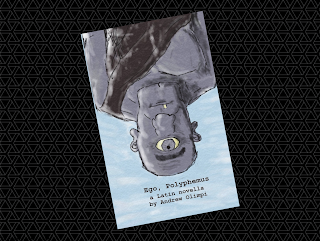Pēgasus et Bellerophon
 Pēgasus et Bellerophon (Pegasus and Bellerophon) is a sheltered-vocabulary Latin novella published by Rachel Beth Cunning in 2020. It tells the story of Pegasus the winged horse, who longs to have a true friend. He meets the human Bellerophon and tries to learn how to trust him for the sake of friendship. It is notable for its exciting mythological story told from the perspective of Pegasus, and for being in somewhat simpler language than other works by this author.
Pēgasus et Bellerophon (Pegasus and Bellerophon) is a sheltered-vocabulary Latin novella published by Rachel Beth Cunning in 2020. It tells the story of Pegasus the winged horse, who longs to have a true friend. He meets the human Bellerophon and tries to learn how to trust him for the sake of friendship. It is notable for its exciting mythological story told from the perspective of Pegasus, and for being in somewhat simpler language than other works by this author.Available from the author's website (bulk discounts available) or from Amazon.
Reading level
The author’s website states that this novellas is intended for readers in their first or second year of study. As of this writing, it has not yet been rated by Comprehensible Antiquity.
Diverse & Multicultural Identities
For information about how representation of multicultural and diverse identities is analyzed in LNDb, see here.Parallel cultures
No depictions identified.Gender
Features one cis male main character (Pegasus). Features no cis female main characters or transgender main characters.Sexual identity
No depictions identified.SES/class
No depictions identified.Religion
No depictions identified.Disability
No depictions identified.Language Statistics
Vocabulary
Word List
A complete word list for Pēgasus et Bellerophon can be found here.
Glosses
This novella contains glosses in the form of both footnotes with English translations and pictures.
Of the 144 unique words (not counting proper nouns) used in the text, 22.0 of them (15.3%) are glossed at their first appearance in the text. Of the 4236 total words in the text, 75.0 of them (1.8%) are glossed.
Of the 144 unique words (not counting proper nouns) used in the text, 22.0 of them (15.3%) are glossed at their first appearance in the text. Of the 4236 total words in the text, 75.0 of them (1.8%) are glossed.
Glossary
This novella contains a Latin-English glossary, with every form of each word listed separately. A second, separate glossary lists the words by headword only. The glossary is complete.
Syntax
The ratio of complex sentences indicates what proportion of the total sentences are complex sentences, on average. A complex sentence is defined as a sentence with one or more subordinate clauses or verb phrases.
Summary
Genre & Sources
This novella is in the genre of mythological (Classical).
It is an adaptation of the story of Bellerophon and Pegasus, found in numerous classical sources.
It is an adaptation of the story of Bellerophon and Pegasus, found in numerous classical sources.
Complete Plot Summary
CONTAINS SPOILERS
Pegasus is a winged horse. He is fiercely independent and proud—he can’t stand being called a “horse” or an “animal”—but longs for a true friend. Minerva appears to him and prophesies that a man with a bridle will come to him, and if Pegasus helps the man, Pegasus will find true friendship. Shortly afterward, a man named Bellerophon comes to Pegasus with a bridle. Pegasus does not want to wear the bridle, but reluctantly agrees because of Minerva’s prophecy. Bellerophon gets on Pegasus and they go off to fight the chimaera, a fire-breathing monster. Bellerophon is very confident, but has no plan for killing the chimaera. Pegasus comes up with the idea to put metal onto his weapon and throw it into the chimaera’s mouth. The fire-breath melts the metal, which goes down the chimaera’s throat and kills it. Bellerophon takes all the credit for the idea and for killing the chimaera, to Pegasus’s chagrin. Next, Bellerophon decides that Pegasus should fly to Mount Olympus to see the gods, which Pegasus knows to be a bad idea. On the way, Pegasus is bitten by a fly, causing Bellerophon to fall off and become seriously injured. Pegasus meets Aurora, goddess of the dawn, who explains that the fly was sent by Jupiter to punish Bellerophon for his hubris. Pegasus realizes that the true friend from Minerva’s prophecy was not Bellerophon, but Aurora, and they fly off together.
First 100 Words
Underlined words are glossed in the text.Ego sum Pēgasus. Volāre in caelō mē dēlectat. Ego vērē possum volāre quia ego nōn sum equus. Ego habeō ālās! Nōn mē dēlectat in terrā ambulāre! Ambulāre mē vexat quia ego possum volāre. Quis ambulet sī possit volāre in caelō?! In caelō, ego possum vidēre omnia! In caelō, ego sum līber!
Ego tamen in caelō nōn possum habitāre. Ego habitō sōlus in terrā in silvā. Sum sōlus quia ego nōn habitō cum familiā. Cum amīcīs ego quoque nōn habitō. Ego vērē nōn habeō amīcōs, et familiam nōn habeō.
Sōlus sum. Ego tamen nōlō esse sōlus. …
Supplementary Materials
If you have resources for Pēgasus et Bellerophon and would like to share them on LNDb, please contact me.Presentation
| Illustrations? | yes |
| Illustrator | various public domain artwork/clip art |
| Macrons? | yes |
| Font | Georgia |
| Pages of story | 72 |
| Total pages | 122 |
| Chapters | 11 |
Key Information
| Publication date | July 15, 2020 |
| Publisher | Independently Published |
| ISBN | N/A |
| ISBN-13 | 979-8655695818 |

